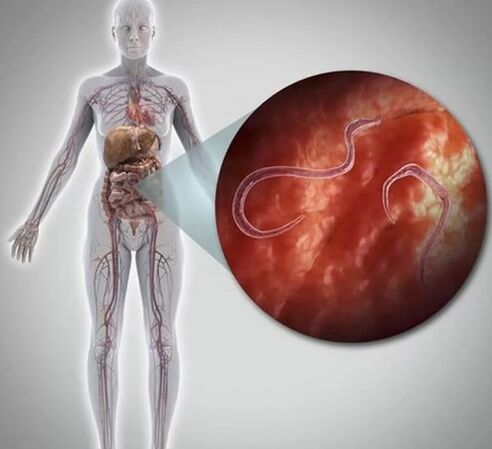Human parasites are parasites, whose infection is subject to person. The general definition of the word "parasite" is applied not only to multi-pole and protozoa, which lives in the detriment of their owner and the detriment of the latter, but also viruses, bacteria and fungions with similar qualities. According to the historical tradition, and from the position of medical parasitology, it is common to call any creatures leading parasitic lifestyle, except for viruses and bacteria with similar qualities.

Parasites include numerous helmints, fungi, viruses, protozoa, CRM, crabs, spider-spider, insects. Parasite owners can be bacteria, simplest, plants, animals and people. Parasites are subject to a complex development cycle: sometimes they need a change in 2-3 owners whose body is medium (Helminthes pass the phase larva) or the final (Helminths become invasive).
From history:
The study of parasites in ancient people is based on the study of feces and other petrified materials. The earliest parasites found in man were paragonimimous westerman eggs from northern Chile, discovered in a hardened feces and from about 5900. years before Christ. e. The Brazil egg whore was found in Brazil with 5, 000. Years before the new era. e. , in Peru - nematodod ogs from 2330. years before the new era. e. And the Egyptian mummies exit 2000. , 1250 and 1000 years. BC. e. They contained a solit egg, along with a well-created female worm.
In Berlin, for the period 1866-1875. 16% of all open corpses contained worms worms. Bull Tanusno (Taeniarhynchus Saginatus) was especially widespread where the creepy cattle was eating. In St. Petersburg, according to Kessler, 3, 66% of persons who have investigated from it suffered from this parasite (1888). Pork Tequenija (Taenia Solium) is located everywhere in areas where raw or semi-raw pork are eaten. In St. Petersburg, in the late 19th century. About 3% of the population suffered from this parasite. When they began to avoid the use of raw meat, for example, the percentage of the disease was reduced in Denmark from 53% to 20% in 10-12 years. Dypilidium Caninum lives in the gut of dogs and cats, and rarely in the hips of children. Cases of children's infection at the end of 19. centuries were known from England, Germany, Denmark: Infection occurs exclusively when fleas are swallowed.
Parasites and their discharge(Products of their lives) are the strongest poisons for the human body. They cause serious greasy and thickening of blood and overall internal environment. They provoke the most serious health disorders. From bronchitis to oncology. Destroy a person's psyche, deprive peace and sleep. In the child's body, the parasites prevent the normal development of the child's nervous system and, with a long current disease, contribute to the mental and physical backlog.
Classification
Distribution:

- Ubiquette - Meet everywhere.
- Tropical - distributed in tropical climatic zones.
About biological and epidemiological characteristics:
- Geohelminths is a disease in which the germ is developing for the first time in the human body, and then unimportant substrates, more often in the country.
- Biohelminths is a disease in which the body of other living beings must be held in the body of Helminth Development, except for the person. They vary between end owners, in which the body can be found for clays for sexually mature stage, as well as medium, where the parasite in the liring phase or its reproduction is not sexually. The person is more often the ultimate owner, less often - medium.
- Contact Helminthiasis is a disease in which parasites differ from the human body mature or almost mature, as a result of another person's infection, or re-infection of themselves (auto-invasion, re-invasion).
Depending on the localization of the parasite in the body:
- Enlightenment - living in the hose cavity and other cavities of a person (for example, ascarides, ribbons).
- Fabric - lives in fabrics (systematis, echinococcose).
At the place of residence on the owner:
- Outdoor: mosquitoes, blind, leeches, ears.
- Inner(Helminthias):Round worms(Nematodes - Ascarids, Philaria, Vlasov, Pinworms, Strungyloids, Anclonstomidae, Trichinella);Flat worms:
- Trematodes (plates - cat Bickelter (desisthorchis), cloner, fashillo, schistosomi);
- Cestodes (ribbons - Tape and Pork Tapeworm, sunbathing dwarf, wide strip, echinococcus).
- Bacteriosis(Leptospira, staphylococcus, streptococcus, shigella).
- Proto(Amebas, Giardia, Trichomonas, often owners of chlamydia and AIDS virus).
- Mycosis(Fungal diseases) - Candida, cryptococcus, penicillium.

How do parasites come into the body?
Parasitism can be infected not only with dirty hands. Animal hair is a worm holder (ascaride and toxocar), Lamblia. Pin eggs that fell from wool remain sustainability up to 6 months and through dust, toys, carpets, underwear and bedding and hands fall into food. The dog through humid breathing scatters eggs at a distance of 5 meters (cat - up to 3 meters). The fleas from dogs also bear the church eggs. Askarid eggs enter the body with poorly washed vegetables, fruits, berries, greenery, dirty hands and spread to flies. And a miscuted barbecue or domestic Lard is the path of a trichinosis infection; Bad salty fish, caviar - desisthorchiasis and a wide cassette.
So there are several ways to enter the body:
- Alimentary (through infectious food, water, dirty hands);
- Contact-household (through homes, from infected family members, pets);
- Portable (through blood insects);
- Percutaneous or active (in which larva penetrates the skin or mucosa during contact with infected soil, when they bathe in open tanks).
Symptoms of parasites
This is not necessary for the infection for somehow to manifest it. Sometimes a person feels healthy, despite invasion, thanks to strong immunity. Someone individual time will be healthy. Then, accordingly, extinction of immunity (failure can occur at any time stress, surgery, disease) - the silent signals parasite will still begin to serve. This is urine with a scent, acne on the skin, stubborn cough with pure lungs, unstable chairs with an intensified smell or closed, mouth, an unpleasant odor from the mouth. The most processive manifestation of the presence of helminat in the body is Bruxism (night rattling of the teeth). Night salivation, common nausea, pervert of appetite night hunger, relentless hunger, addiction about sweet and sour foods and skates. Children have a drop in appetite or election appetite. Sometimes people are found with increased appetite, but at the same time they lose weight.
General signs of parasitic invasions
Prison, stagnation bile

Some worms, due to their shape and large sizes, can mechanically close lumen on the intestines, biliar tract channels that lead to deterioration in peristalsis, forming a closure, complete or partial intestine. Hlybone invasion can cause a blockade of a common bile channel, which leads to the difficulty in the outflow of bile, mechanical jell.
Diarrhea
Numerous parasites, especially protozoal, producing substances similar to prostaglandins, which leads to sodium and chloride for loss, which in turn, causes diarrhea - frequent water engine for hose.
Gastrinski and intestinal uneasy syndrome
Parasites living in the upper intestine cause inflammation and lead to bowel disorders, inflates. This leads to a reduction in the absorption of nutrients. As a result, fat that should be absorbed in the thin hose fall into the colon, cause cramps, alternating prinths and diarrhea.
Joint pain and muscles
The parasites can move around the human body to accelerate in the most suitable places, for example, in a common liquid and in muscles. Inflammation of fabric is the result of parasite injuries or the body's immune response to their presence. At the same time, a person experiences muscles and joint pain.
Allergy
Parasites may disrupt normal intestinal mucosa permeability, which increases the risk of penetrating large non-digestive food particles into them. This activates the immune response of the body - the level of eosinophil - the protective blood cells of our body, which contribute to the development of allergic reactions, increases. Parasites cause increased production by the body of immunoglobulin E, which improves allergic reactions.
Skin problem
Intestinal parasites can cause allergic skin reactions - atopic dermatitis, urticaria, eczema. The most common inflammatory changes on the skin can be the result of the presence of protozoac microorganisms (lamblia, mushrooms) and desisthorchis.
Change body weight
Weight fluctuations (and more than normal and less) can be the result of a parasitic disease. The reduction of weight is due to the fact that digestion is relieved in the body, because there is an "internal consumer". Obesity is also the consequence of the "robbery" of the human body with Herminhic invasion. The feeling of hunger happens with a sharp drop in blood sugar due to Helmintha's activity, their toxic effects on the body.
Anemia
Many types of herminths are attached to the intestinal wall, damaged by, causing a sufficiently higher blood loss, leading to anemia.
Nervousness, sleep disorder
Toxic substances Vital activity of the parasite irritate the central nervous system, causing increased anxiety and nervousness. Frequent awakening in the middle of the night, especially between 2 and 3 hours, is also the result of the body attempt to solve the domestic substances through the liver.
"Chronic tired syndrome"
The "chronic tired syndrome" includes weakness, carelessness and fever, emotional instability, loss of concentration and bad memory. These symptoms can be the result of anemia, intoxication, lack of nutrients in the body caused by parasites.
By discovering your family members several symptoms, they undergo diagnostics of parasitism and conduct a flow of preventive treatment from motor products.

Diagnostics
Recently, the presence of the parasites is determined only by the method of sound tests and feces of the duodenal and relocations using microscopic studies, whose purpose is to detect selected herminates or their fragments, eggs and larvae. Eggs and larvae of Helminths parasites in the liver, biliary trails, pancreas and two-walled are found in bile and duodenal facilities; Helminthias in the intestinal forms of Helminthias examined the samples of feces; In case of doubt in paragonymos, sputum spurs, and urine - urine on the genitourian shrimp. But the reliability of these studies depends on the professionalism of employees - whether the laboratory assistant will notice in the microscope examination of parasites. In addition, if the parasite does not postpone the eggs at the time check, its presence will be unnoticed even with high qualifications of the laboratory assistant. Often only with 8-10 attempts you can get a positive result.
Today, there are immune studies that allow you to determine the presence of antigen and antibodies in the blood in the blood to parasites about various types. The reliability of such analyzes depends on the life cycle of the parasites and their quantity in the body.
The most vulnerable to parasite effects are children. They are infected with different types of parasites through dirty hands, sand, soil and water. Sometimes intrauterine can occur in intrauterine, because the simplest, bacteria, viruses, candida and herminth larva can penetrate the fruit through the flow of blood, as well as during birth through the birth of channels.
Do not risk your children's health, implement preventive removal courses.






































